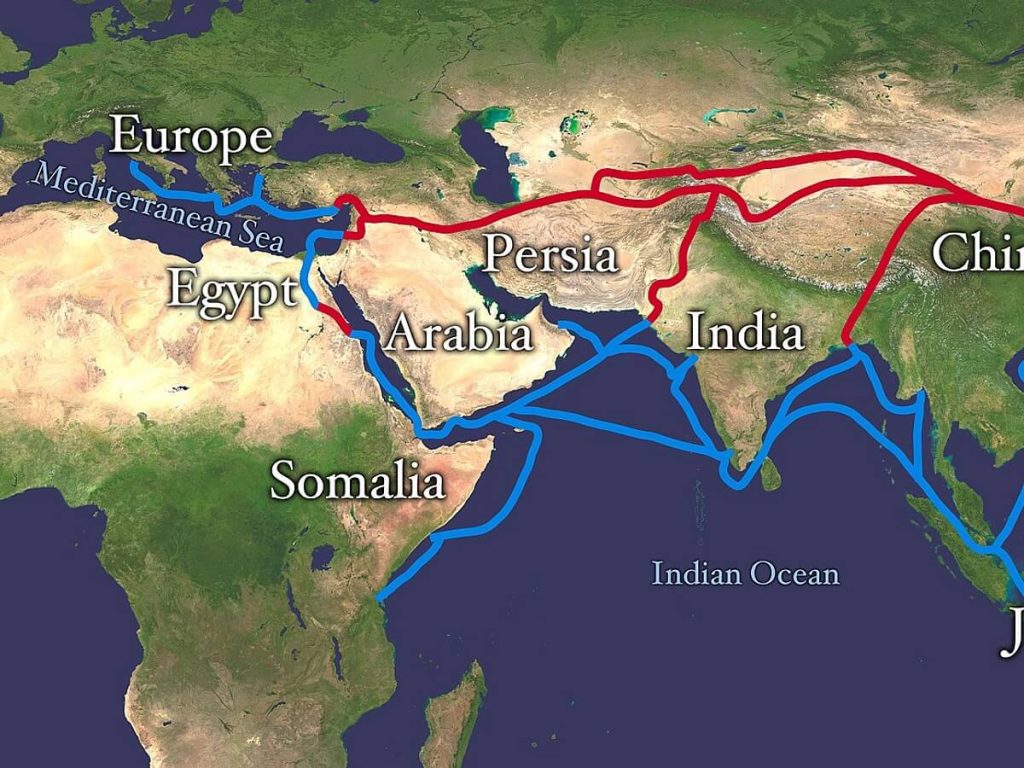
English Project on Silk Road for Class 11th CBSE
Acknowledgment
Embarking on the exploration of the Silk Road and delving into its rich historical tapestry has been an enlightening journey, one that has been made possible through the contributions and support of various individuals and resources. As we extend our gratitude, we wish to express our heartfelt thanks to all those who have played a role in the completion of this project.
First and foremost, our sincere appreciation goes to the scholars, historians, and researchers whose extensive work has provided the foundation for our understanding of the Silk Road. Their dedication to unraveling the complexities of this ancient trade network has been instrumental in shaping the narrative presented in this project.
We extend our gratitude to the academic institutions and libraries that have been invaluable in providing access to a wealth of resources and literature. The vast repositories of knowledge have been crucial in conducting thorough research and ensuring the accuracy of the information presented.
Special thanks are due to our mentors and advisors, whose guidance and insights have steered this project towards a comprehensive and nuanced exploration of the Silk Road. Their expertise and encouragement have been instrumental in refining our approach and elevating the quality of our work.
To the diverse cultures and civilizations that once thrived along the Silk Road, we express our admiration and respect. The enduring legacy of the exchanges in art, religion, and technology has enriched humanity, and it is with humility that we acknowledge the profound impact of these historical interactions.
Last but not least, we extend our gratitude to the collaborative spirit of the team involved in this project. Each member has brought unique perspectives, skills, and dedication, contributing to the cohesive and well-rounded exploration of the Silk Road.
In conclusion, this project stands as a collective effort, and we acknowledge with gratitude the invaluable contributions of all those who have played a part, directly or indirectly, in bringing this exploration to fruition.
Introduction
The Silk Road, a historic network of trade routes spanning from the East to the West, represents a tapestry of human interaction, cultural exchange, and economic dynamics that shaped the course of history. In the intricate web of these ancient routes, civilizations converged, and commodities traversed vast distances, leaving an indelible imprint on the global landscape. This project seeks to unravel the multifaceted significance of the Silk Road, delving into its economic impact, cultural exchanges, and technological transmissions that echo through the annals of time.
As we embark on this exploration, we delve into the origins of the Silk Road during the Han Dynasty in China, tracing its expansion through overland and maritime routes. We unravel the decline of this once-thriving network, influenced by factors ranging from the rise of maritime trade routes to political upheavals and the spread of diseases. The journey takes us through the key trade goods that flowed along these routes, from China’s coveted silk to Middle Eastern spices and European glassware, revealing the diverse tapestry of goods exchanged.
Moreover, our exploration extends beyond commodities to the rich cultural exchanges that occurred along the Silk Road. From the spread of religions like Buddhism to the fusion of artistic styles and architectural influences, the Silk Road stands as a testament to the interconnectedness of human societies.
This project is a tribute to the countless individuals, cultures, and civilizations that contributed to the legacy of the Silk Road. It is a journey through time, unraveling the threads that connected East and West, and appreciating the enduring impact of these exchanges on the world we inhabit today. Join us in this exploration of the Silk Road, where history unfolds and where the echoes of ancient trade routes resonate in the contemporary global tapestry.

Historical Overview
- Origin: The roots of the Silk Road trace back to the Han Dynasty in China (206 BCE – 220 CE), marking the establishment of the foundational trade routes. This period laid the groundwork for centuries of cultural and economic exchange that would shape the development of societies along the Silk Road.
- Expansion: Silk Road’s expansive reach included overland routes that spanned from China to the Mediterranean, traversing Central Asia, Persia, and the Middle East. Additionally, maritime routes played a significant role, linking the Mediterranean with East Asia through the vast expanse of the Indian Ocean. This complex network facilitated the movement of goods, ideas, and people across continents.
- Decline: Despite its historical significance, the Silk Road eventually faced a decline. Factors contributing to this decline included the rise of alternative maritime trade routes, political instability in certain regions, and the spread of diseases, marking the end of an era.
Key Trade Goods
- Chinese Goods: Chinese exports along the Silk Road included the highly sought-after silk, known for its luxurious texture and vibrant colors. Additionally, Chinese tea, symbolizing refinement, became a popular commodity in the extensive trade network.
- Middle Eastern Goods: Middle Eastern merchants brought exotic spices such as cinnamon, pepper, and nutmeg to the East, enriching the palates of distant civilizations. Fine textiles, including carpets and tapestries, were also in high demand, showcasing the diversity of goods traded along the Silk Road.
- European Goods: European contributions to the Silk Road trade included valued glassware and glass products, as well as precious metals like gold and silver. These commodities flowed from Europe to the East, further emphasizing the interconnected nature of the Silk Road trade.

Cultural Exchanges
- Spread of Religions: The Silk Road played a pivotal role in the spread of religions, with Buddhism making its way from India to East Asia. Additionally, Islamic culture and ideas permeated along the trade routes, influencing various societies and contributing to the rich tapestry of cultural exchanges.
- Art and Architecture: The Silk Road contributed to the fusion of artistic styles, blending Eastern and Western influences. This fusion extended beyond art to architecture, where different styles and techniques were shared and adopted along the vast trade routes. The Silk Road thus stands as a testament to the interconnectedness of civilizations and the enduring impact of cultural exchange on the course of history.
Economic Impact
- Trade Networks: The Silk Road was a complex network of interconnected trade routes that facilitated the exchange of goods, fostering economic prosperity for regions involved in the trade.
- Entrepreneurial Spirit: The Silk Road not only exchanged physical goods but also sparked an entrepreneurial spirit, with merchants navigating vast distances and diverse cultures for economic gain.
Cultural Exchange
- Language and Communication: The Silk Road served as a melting pot of languages and communication, as merchants and travelers had to navigate various linguistic landscapes.
- Cultural Fusion: The crossroads of civilizations along the Silk Road led to a fusion of cultural elements, giving rise to a unique blend of traditions, art, and lifestyles.
Technological Transmission
- Innovations in Technology: The transfer of technologies and innovations along the Silk Road had a transformative effect on societies, influencing advancements in agriculture, manufacturing, and more.
- Knowledge Transfer: The Silk Road was not only a physical trade route but also a conduit for the exchange of knowledge, with scholars, scientists, and artisans sharing expertise.
Historical Overview
- Shifts in Power: The Silk Road played a role in the ebb and flow of power dynamics, with empires rising and falling as a result of their involvement in this vast trade network.
- Legacy of the Silk Road: Despite its decline, the legacy of the Silk Road persisted, influencing subsequent trade routes, diplomatic relations, and global perspectives.
Decline and Factors
- Rise of Maritime Trade: The emergence of maritime trade routes, offering faster and more direct connections, contributed to the decline of overland Silk Road routes.
- Political Instability: Periods of political unrest and changing borders along the Silk Road impacted the safety and efficiency of trade, leading to a decline in its prominence.
Key Trade Goods
- Textile Innovations: Beyond silk, the Silk Road witnessed the exchange of textile innovations, leading to the introduction of new weaving techniques and fabric styles.
- Spices and Culinary Influences: Middle Eastern spices introduced to the East and vice versa had a profound impact on culinary traditions along the Silk Road.
Cultural Exchanges
- Literary Contributions: The exchange of literature, manuscripts, and writings along the Silk Road enriched the intellectual landscape of the involved regions.
- Architectural Marvels: Architectural styles and techniques traveled along the Silk Road, influencing the construction of buildings and structures in diverse regions.
Conclusion
In the intricate tapestry of human history, the Silk Road stands as a testament to the resilience of human endeavor, the interconnectedness of civilizations, and the enduring legacy of cross-cultural exchanges. As we conclude this exploration of the Silk Road, it becomes apparent that this ancient trade network transcended mere commerce, leaving an indelible mark on the economic, cultural, and technological landscapes of the regions it touched.
Economically, the Silk Road was not just a conduit for the exchange of goods; it was a catalyst for economic prosperity and entrepreneurial ventures that spanned continents. The sheer scale and complexity of this trade network showcased the resilience and resourcefulness of those who navigated its routes in search of fortune and prosperity.
Culturally, the Silk Road was a melting pot where languages, traditions, and artistic expressions intertwined. It fostered a rich tapestry of cultural fusion, where diverse civilizations learned from and influenced one another. The legacy of this cultural exchange endures in the diverse traditions, art forms, and even culinary practices that continue to enrich the global mosaic.
Technologically, the Silk Road was a conduit for the transfer of knowledge and innovation. From advancements in agriculture to the exchange of scientific ideas, the Silk Road played a pivotal role in shaping the technological landscape of the civilizations it connected. The ripple effects of these technological transmissions reverberate through the corridors of time.
As we reflect on the historical overview, it becomes evident that the Silk Road was not static but a dynamic force that contributed to the rise and fall of empires, the reconfiguration of political boundaries, and the evolution of global trade. Its decline, influenced by the rise of maritime routes and political instability, marked the end of an era but not the end of its enduring impact.
In considering the key trade goods, we witness how commodities like silk, spices, and precious metals were more than just items of trade; they were cultural symbols that transcended geographic boundaries. The Silk Road was a conduit not only for physical goods but also for the intangible threads of culture, spirituality, and intellectual pursuits.
In the realm of cultural exchanges, the Silk Road facilitated the spread of religions, the fusion of artistic styles, and the exchange of architectural influences. Its legacy is imprinted in the cultural diversity that defines the modern world, with echoes of the Silk Road’s impact resonating in art, religion, and architecture.
In conclusion, the Silk Road project invites us to marvel at the resilience of human connections across time and space. It prompts us to appreciate the rich tapestry of our shared history and to recognize that the echoes of the Silk Road continue to reverberate in the modern interconnected world. As we bid farewell to this exploration, we carry with us a deeper understanding of the Silk Road’s profound impact on the human journey through time.
Bibliography
- “The Silk Road: A New History” by Valerie Hansen
- “The Silk Roads: A New History of the World” by Peter Frankopan
- “Silk Road: Monks, Warriors & Merchants” by Luce Boulnois
- “The Silk Road: Trade, Travel, War and Faith” by Susan Whitfield
- “Empires of the Silk Road: A History of Central Eurasia from the Bronze Age to the Present” by Christopher I. Beckwith
- “The Silk Road: A Very Short Introduction” by James A. Millward
- “Silk Road: Drugs, Death, and the Dark Web” by Eileen Ormsby
- “Life along the Silk Road” by Susan Whitfield
Certificate of Completion
[Student’s Name][Class/Grade Level]This is to certify that I, [Student’s Name], a [Class/Grade Level] student, have successfully completed the “English Project on Silk Road for Class 11th CBSE.” The project explores the fundamental principles and key aspects of the chosen topic, providing a comprehensive understanding of its significance and implications.
In this project, I delved into in-depth research and analysis, investigating various facets and relevant theories related to the chosen topic. I demonstrated dedication, diligence, and a high level of sincerity throughout the project’s completion.
Key Achievements:
Thoroughly researched and analyzed English Project on Silk Road for Class 11th CBSE .
Examined the historical background and evolution of the subject matter.
Explored the contributions of notable figures in the field.
Investigated the key theories and principles associated with the topic.
Discussed practical applications and real-world implications.
Considered critical viewpoints and alternative theories, fostering a well-rounded understanding.
This project has significantly enhanced my knowledge and critical thinking skills in the chosen field of study. It reflects my commitment to academic excellence and the pursuit of knowledge.
Date: [Date of Completion]Signature: [Your Signature] [School/Institution Name][Teacher’s/Examiner’s Name and Signature]
In order to download the PDF, You must follow on Youtube. Once done, Click on Submit
Follow On YoutubeSubscribed? Click on Confirm
Download English Project on Silk Road for Class 11th CBSE PDF






